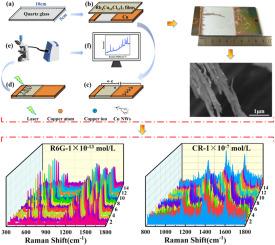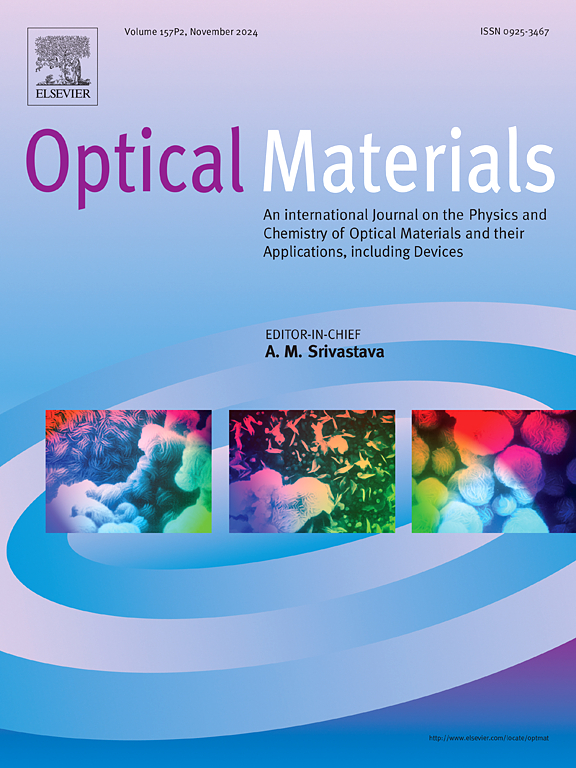Dendritic copper nanostructures for ultrasensitive detection of rhodamine 6G and Congo red
IF 3.8
3区 材料科学
Q2 MATERIALS SCIENCE, MULTIDISCIPLINARY
引用次数: 0
Abstract
Surface-Enhanced Raman Scattering (SERS) is a fast-responding and non-destructive ultra-sensitive detection technique that can replace traditional chromatographic and spectroscopic analysis techniques. In this experiment, dendritic copper nanostructures were prepared by the solid-state ionics method and the vacuum hot evaporation process with an applied current of I = 9 μA. Using them as a SERS substrate, Raman detection was performed on the dye molecules Rhodamine 6G (R6G) and Congo Red (CR) to determine SERS enhancement performance. It is found that the growth of the prepared copper nanostructures has a top-end dominant phenomenon. The fractal dimension of the copper nanostructure was calculated using fractal theory, and it was revealed to be 1.560. Scanning electron microscopy (SEM) results showed that a large number of 60–80 nm regularly arranged copper nanoparticles were attached to the surface of the dendritic copper nanostructure. This is beneficial to increase the surface roughness of the substrate and improve the detection level of dye molecules. Subsequently, copper nanostructures can sensitively detect R6G and CR solutions as low as 1 × 10−13 mol/L and 1 × 10−7 mol/L, reaching single-molecule levels. The Raman mapping experiment showed that the mean relative standard deviation (RSD) values of R6G and CR were 12.3 % and 12.9 %, indicating high uniformity and reproducibility of the structure. This structure effectively achieves the fusion of uniformity, repeatability, and sensitivity, and shows broad application prospects in food detection.

用于罗丹明 6G 和刚果红超灵敏检测的树枝状纳米铜结构
表面增强拉曼散射(SERS)是一种快速反应、非破坏性的超灵敏检测技术,可以取代传统的色谱和光谱分析技术。本实验采用固态离子法和真空热蒸发工艺制备了树枝状纳米铜结构,外加电流为 I = 9 μA。利用它们作为 SERS 基底,对染料分子罗丹明 6G (R6G) 和刚果红 (CR) 进行了拉曼检测,以确定 SERS 的增强性能。研究发现,所制备的纳米铜结构的生长具有顶端主导现象。利用分形理论计算了纳米铜结构的分形维数,结果显示为 1.560。扫描电子显微镜(SEM)结果表明,树枝状纳米铜结构表面附着了大量 60-80 nm 规则排列的纳米铜粒子。这有利于增加基底的表面粗糙度,提高染料分子的检测水平。随后,纳米铜结构可以灵敏地检测低至 1 × 10-13 mol/L 和 1 × 10-7 mol/L 的 R6G 和 CR 溶液,达到单分子水平。拉曼图谱实验表明,R6G 和 CR 的平均相对标准偏差(RSD)值分别为 12.3 % 和 12.9 %,表明该结构具有高度的均匀性和可重复性。该结构有效地实现了均匀性、可重复性和灵敏度的融合,在食品检测领域具有广阔的应用前景。
本文章由计算机程序翻译,如有差异,请以英文原文为准。
求助全文
约1分钟内获得全文
求助全文
来源期刊

Optical Materials
工程技术-材料科学:综合
CiteScore
6.60
自引率
12.80%
发文量
1265
审稿时长
38 days
期刊介绍:
Optical Materials has an open access mirror journal Optical Materials: X, sharing the same aims and scope, editorial team, submission system and rigorous peer review.
The purpose of Optical Materials is to provide a means of communication and technology transfer between researchers who are interested in materials for potential device applications. The journal publishes original papers and review articles on the design, synthesis, characterisation and applications of optical materials.
OPTICAL MATERIALS focuses on:
• Optical Properties of Material Systems;
• The Materials Aspects of Optical Phenomena;
• The Materials Aspects of Devices and Applications.
Authors can submit separate research elements describing their data to Data in Brief and methods to Methods X.
 求助内容:
求助内容: 应助结果提醒方式:
应助结果提醒方式:


